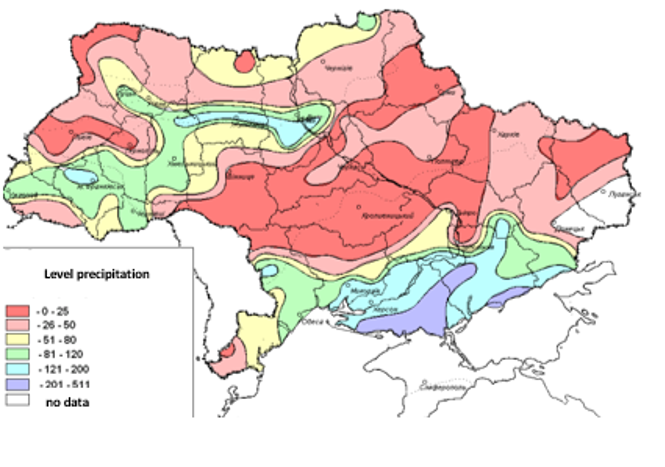The weather in Ukraine was influenced by various atmospheric phenomena during the last ten days of July. The hot Mediterranean air caused the air temperature to rise from moderate warmth at the beginning of the ten-day period to hot on most days. In the last days of the month, the movement of the cold atmospheric front brought another decrease in the temperature background by 3-7 °C. Rains were noted almost throughout the country, their distribution was variegated, the number varied from insignificant and small in most territories to temperate, in places (mainly south and southeast) there were significant showers with thunderstorms, squalls and hail. The least precipitation was noted in the central regions.
The average regional ten-day air temperature turned out to be 1.5-3.4 °C above the norm and ranged from 20 to 25 °C. The maximum air temperature on the warmest days increased to 35-37 °C, and in the western, Zhytomyr and Chernihiv regions – up to 28-34 °C.
Precipitation of varying intensity (from weak and moderate to heavy showers, in places with squalls, thunderstorms and hail) was observed for 1-6 days. In the Ternopil, Rivne, Transcarpathian, Chernivtsi, Khmelnytsky, Zhytomyr, Kyiv, Dnipropetrovsk, Donetsk, Odesa and Mykolayiv regions, the average regional number for ten days was 59-92% of the norm (10-23 mm). The largest amount of precipitation over ten days was noted in the Ivano-Frankivsk, Zaporozhzhya and Kherson regions – 129-275% of the norm (33-54 mm), in the rest of the territory precipitation fell much less than the norm -9-48% (1-12 mm), and some districts of the central regions were completely dry.

The weather conditions in July (minor rains – 25-50% of the norm, the temperature background increased by 2-2.5 °C) caused a significant deterioration in soil moisture in most areas of the central and southern regions, where the reserves of productive moisture in a meter layer of soil under all crops were 2-3 times less than the optimal indicators for the current growing season and did not exceed 20-40 mm. In the southern regions (Mykolayiv, Odesa, Kherson, Zaporozhzhya) in many areas the moisture reserves of a meter layer of soil have already been completely exhausted. Only in some areas of the Zaporozhzhya and Kherson regions with effective precipitation, a decrease in temperature and an increase in relative air humidity, there was a softening of the growing season of late crops. According to the observations of agrometeorologists, in many areas the corn grain reached milky ripeness 1.5-2.5 weeks earlier than usual, and sunflower seeds ripening began almost 2-3 weeks earlier than usual. Agrometeorological conditions in the western regions were assessed as favorable for most agricultural crops, which was facilitated by the accumulation of effective air temperatures and sufficient moisture reserves. However, due to frequent small rains, local waterlogging of the upper layers of the soil was observed, which made it difficult to harvest grain. In most of the northern regions, very warm, sometimes hot weather and sufficient moisture supply in the soil were favorable factors for the formation of the harvest of late industrial crops, vegetables and root crops.